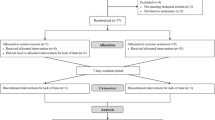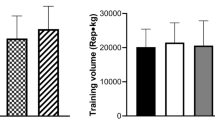Abstract
Background
The post-exercise hypotension response (PEH) has been shown to be dependent on the load and volume of a resistance training (RT) prescription.
Aim
The aim of the present study was to compare the PEH between a low-load and high-volume and a high-load and low-volume RT session.
Methods
Ten young men with more than 2 years of RT experience participated in the study. All subjects were submitted to 5 and 15 repetition maximum tests, in counterbalanced order, for the following exercises: back squat, chest press, leg press and wide grip pulldown. Then, the subjects performed two protocols (P5 and P15) that consisted of three sets to volitional failure with 2-min rest intervals between sets and exercises. Blood pressure (BP) and heart rate (HR) were measured before and after 60 min following each session at 10-min time points.
Results
Significantly greater total training volume was observed for all exercises in P15 (p < 0.05), whereas a significantly greater load was observed in P5 (p < 0.05). It was observed that the P15 session stimulated a greater PEH, with small to large effect sizes at various time points post-exercise, while the effect sizes for the P5 session were trivial in magnitude. Additionally, a significantly greater HR response was observed for the P15 versus the P5 during the recovery period.
Conclusion
Low-load and high-volume RT stimulated greater PEH compared to high-load and low-volume RT, suggesting the importance of RT volume in promoting healthy BP.



Similar content being viewed by others
References
Figueiredo T, de Salles BF, Dias I, Reis VM, Fleck SJ, Simão R (2013) Acute hypotensive effects after strength training session: a review. Int Sportmed J 15:308–329
Chen C, Bonham AC (2010) Postexercise hypotension: central mechanisms. Exerc Sport Sci Rev 38:122–127
Halliwill JL, Buck TM, Lacewell AN, Romero SA (2013) Postexercise hypotension and sustained postexercise vasodilatation: what happens after we exercise? Exp Physiol 98:7–18
Angadi SS, Bhammar DM, Gaesser GA (2015) Postexercise hypotension after continuous, aerobic interval, and sprint interval exercise. J Strength Cond Res 29:2888–2893
Macdonald JR (2002) Potential causes, mechanisms, and implications of post exercise hypotension. J Human Hypertens 16:225–236
Bentes CM, Costa PB, Neto GR, Costa e Silva GV, De Salles BF, Miranda HL et al (2015) Hypotensive effects and performance responses between different resistance training intensities and exercise orders in apparently health women. Clin Physiol Funct Imaging 35:185–190
Brito AF, Brasileiro-Santos MS, de Oliveira CVC, da Nóbrega TKS, Forjaz CLM, da Cruz AS (2015) High-intensity resistance training promotes postexercise hypotension greater than moderate intensity and affects cardiac autonomic responses in women who are hypertensive. J Strength Cond Res 29:3486–3493
Brito AF, De Oliveira CV, Santos MS, Santos AC (2014) High-intensity exercise promotes postexercise hypotension greater than moderate intensity in elderly hypertensive individuals. Clin Physiol Funct Imaging 34:126–132
Cavalcante PAM, Rica RL, Evangelista AL, Serra SJ, Figueira A, Pontes FL et al (2015) Effects of exercise intensity on postexercise hypotension after resistance training session in overweight hypertensive patients. Clin Interv Aging 10:1487–1495
Duncan MJ, Birch SL, Oxford SW (2014) The effect of exercise intensity on postresistance exercise hypotension in trained men. J Strength Cond Res 28:1706–1713
Figueiredo T, Willardson JM, Miranda H, Bentes CM, Reis VM, Simão R (2015) Influence of load intensity on postexercise hypotension and heart rate variability after a strength training session. J Strength Cond Res 29:2941–2948
Figueiredo T, Rhea MR, Peterson M, Miranda H, Bentes CM, dos Reis VMR et al (2015) Influence of number of sets on blood pressure and heart rate variability after a strength training session. J Strength Cond Res 29:1556–1563
Rezk CC, Marrache RCB, Tinucci T, Mion D, Forjaz CLM (2006) Post-resistance exercise hypotension, hemodynamics, and heart rate variability: influence of exercise intensity. Eur J Appl Physiol 98:105–112
Scher LML, Ferriolli E, Moriguti JC, Scher R, Lima NKC (2011) The effect of different volumes of acute resistance exercise on elderly individuals with treated hypertension. J Strength Cond Res 25:1016–1023
Takano H, Morita T, Iida H, Asada K, Kato M, Uno K et al (2005) Hemodynamic and hormonal responses to a short-term low-intensity resistance exercise with the reduction of muscle blood flow. Eur J Appl Physiol 95:65–73
Richens B, Cleather DJ (2014) The relationship between the number of repetitions performed at given intensities is different in endurance and strength trained athletes. Biol Sport 31:157–161
Shimano T, Kraemer WJ, Spiering BA, Volek JA, Hatfield DL, Silvestre DL et al (2006) Relationship between the number of repetitions and selected percentages of one repetition maximum in free weight exercises in trained and untrained men. J Strength Cond Res 20:819–823
Polito MD, Farinatti PT (2009) The effects of muscle mass and number of sets during resistance exercise on postexercise hypotension. J Strength Cond Res 23:2351–2357
Baechle TR, Earle RW (2008) Essentials of strength training and conditioning, 3rd edn. Human Kinetics, Champaign
Miranda H, Maia MF, Paz GA, Costa PB (2014) Acute effects of antagonist static stretching in the inter-set rest period on repetition performance and muscle activation. Res Sports Med 23:37–50
Paz GA, Robbins DW, Oliveira CG, Bottaro M, Miranda H (2017) Volume load and neuromuscular fatigue during an acute bout of agonist-antagonist paired-set vs traditional-set training. J Strength Cond Res 31:2777–2784
Scott BR, Duthie GM, Thornton HR, Dascombe BJ (2016) Training monitoring for resistance exercise: theory and applications. Sports Med 46:687–698
Rhea MR (2004) Determining the magnitude of treatment effects in strength training research through the use of the effect size. J Strength Cond Res 18:918–920
Costa EC, Dantas TC, de Farias Junior LF, Frazão DT, Prestes J, Moreira SR et al (2016) Inter- and Intra- individual analysis post-exercise hypotension following a single bout of high-intensity interval exercise and continuous exercise: a pilot study. Int J Sports Med 37:1038–1043
Schoenfeld BJ (2013) Potential mechanisms for a role of metabolic stress in hypertrophic adaptations to resistance training. Sports Med 43:179–194
Tibana RA, Nascimento DC, de Sousa NMF, Almeida JA, Moraes MR, Durigan JLQ et al (2015) Similar hypotensive effects of combined aerobic and resistance exercise with 1 set versus 3 sets in women with metabolic syndrome. Clin Physiol Funct Imaging 35:443–450
Neto GR, Sousa MSC, Costa PB, de Salles BF, Novaes GS, Novaes JS (2015) Hypotensive effects of resistance exercise with blood flow restriction. J Strength Cond Res 29:1064–1070
Maior AS, Simão R, Martins MSR, de Salles BF, Willardson JM (2015) Influence of blood flow restriction during low-intensity resistance exercise on the postexercise hypotensive response. J Strength Cond Res 29:2894–2899
Pearson SJ, Hussain SR (2015) A review on the mechanisms of blood-flow restriction resistance training-induced muscle hypertrophy. Sports Med 45:187–200
Pope ZK, Willardson JM, Schoenfeld BJ (2013) Exercise and blood flow restriction. J Strength Cond Res 27:2914–2926
Kingsley JD, Figueroa A (2016) Acute and training effects of resistance training exercise on heart rate variability. Clin Physiol Funt Imaging 36:179–187
Kon M, Ikeda T, Homma T, Suzuki Y (2012) Effects of low-intensity resistance exercise under acute systemic hypoxia on hormonal responses. J Strength Cond Res 26:611–617
Scott BR, Slattery KM, Sculley DV, Lockhart C, Dascombe BJ (2017) Acute physiological responses to moderate-load resistance exercise in hypoxia. J Strength Cond Res 31:1973–1981
Author information
Authors and Affiliations
Corresponding author
Ethics declarations
Conflict of interest
The authors of the present study declare that they have no potential conflict interest to disclose.
Ethical approval
All procedures performed in studies involving human participants were in accordance with the ethical standards of the institutional and/or national research committee (CAAE: 51654515.1.0000.5257) and with the 1964 Helsinki declaration and its later amendments or comparable ethical standards.
Informed consent
All subjects of the study signed an informed consent prior to investigation with all experimental procedures.
Additional information
Publisher's Note
Springer Nature remains neutral with regard to jurisdictional claims in published maps and institutional affiliations.
Rights and permissions
About this article
Cite this article
Malheiros, R., Nasser, I., Willardson, J.M. et al. Greater postexercise hypotension response in low-load and high-volume resistance training versus high-load and low-volume resistance training. Sport Sci Health 16, 393–400 (2020). https://doi.org/10.1007/s11332-019-00614-5
Received:
Accepted:
Published:
Issue Date:
DOI: https://doi.org/10.1007/s11332-019-00614-5




